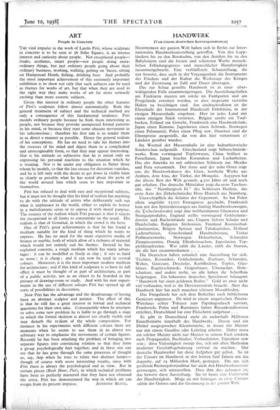ART
People in Concrete
THE vital impulse in the work of Laszlo Peri, whose sculpture in concrete is to be seen at 36 Soho Square, is an intense interest and curiosity about people. Not exceptional people- . freaks, aesthetes, smart people—nor people doing extra-
• ordinary things, but just ordinary people going about their ordinary business, working, walking, getting on 'buses, sitting on Hampstead Heath, fishing, drinking beer. And probably the most important achievement of this extremely important exhibition is to show not only that such subjects can be used as themes for works of art, but that when they are used in the right way they make works of art far more seriously exciting than more esoteric subjects.
Given this interest in ordinary people the other features of Peri's sculpture follow almost automatically. Both the general treatment of subject and the technical method are only a consequence of this fundamental tendency. Peri models ordinary people because he finds them interesting as people, not because they provoke unexpected formal patterns
• in his mind, or because they start some obscure movement in his subconscious ; therefore his first aim is to render them in as direct a manner as possible. Hence the general realism of his conceptions. He has no need to take his themes into the recesses of his mind and digest them to a complicated and unrecognisable form, so that they may appear interesting. Nor is his attitude so subjective that he is intent only on expressing his personal reactions to the situation which he is treating. Nor is he under any obligation to flatter those
• whom he models, so that the last excuse for distortion vanishes, and he is left only with the desire to get down in visible form as clearly as possible what he has noted about the parts of the world around him which seem to him important in themselves.
Peri has refused to deal with rare and exceptional subjects, but it must not be thought that his kind of realism has anything to do with the attitude of artists who deliberately seek out what is unpleasant in the world, either to exploit its horror in a melodramatic sense or to expose it with moral purpose. The essence of the realism which Peri pursues is that it rejects the exceptional in all forms to concentrate on the usual. His realism is that of Germinal, in which the crowd is the hero.
One of Peri's great achievements is that he has found a medium suitable for the kind of thing which he wants to express. He has no need for the more expensive media of bronze or marble, both of which allow of a richness of material which would not entirely suit his themes. Instead he has exploited concrete, a rough medium which has many advan- tages : it can be modelled as freely as clay ; it sets as hard as stone ; it is cheap ; and it can now be used in several colours. Moreover, it is the most important modern medium for architecture; and if this kind of sculpture is to have its full effect it must be thought of as part of architecture, as part of a public activity, not as an object to be hoarded in the privacy of drawing-room or study. And with his new experi- ments in the use of different colours Peri has opened up all sorts of possibilities in decoration.
Now Peri has the advantage and the disadvantage of having been an abstract sculptor and painter. The effect of this is that he still has a great interest in formal and technical .questions for their own sake. Consequently when he attempts to solve some new problem he is liable to go through a stage in which the formal skeleton is almost too clearly visible and
may disturb the realism of the whole composition. For instance in his experiments with different colours there are moments when he seems to use them in an almost too arbitrary way to emphasise the movements of certain figures.
Recently he has been attacking the problem of bringing two separate figures into convincing relation so that they form a group psychologically knit together, and in these one can
see that he has gone through the same processes of thought as, say, Arp when he tries to relate two abstract lumps—
though of course with more interesting results, since with
-Peri there ,is always the psychological end in view. But in certain pieces (Rush Hour, Pier), in which technical problems
have been so perfectly mastered that they have not obsessed the artist, Peri has demonstrated the way in which art can
escape from its present impasse. ANTHONY BLUNT.










































 Previous page
Previous page